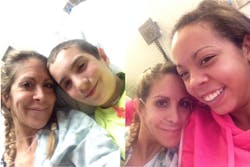Editor's note: This article contains disturbing descriptions of domestic abuse and violence.
Vicki Vertin has worked at the same Ohio practice for over a decade. As a dental hygienist, she’s used to routine, which is why she thought it was odd when someone called the office and asked for her by her full name. Within minutes her ex-boyfriend, Danny Thornton, walked in with a gun and fired at Vicki.
It was later learned he also shot two others, fatally wounding the nine-year old son of another ex-girlfriend. He was killed by police later that day.
Vicki had been stalked by Danny for eleven years, and says she spent the entire time looking over her shoulder. “We have the same social circles and he would try to find out where I worked,” she said. “Once, he got a job making keys in a kiosk outside my previous office. He even traveled to Colorado to catch another ex in a new relationship. I knew he was eventually going to find me.”
“He had been verbally and physically abusive. He would remind me that no man in the world would want me. He constantly told me he would kill me, and, how he would do it. He said he was going to shove a crack rock down my throat after he killed me so they would think it was the drugs,” she said. She believed it was just a matter of time before he followed through. He threatened their daughter if Vicki ever reported him to the police.
Vicki Vertin with her children while she recovered in the hospital. Courtesy Vicki Vertin.
While Vicki’s story is quite powerful to read, it is unfortunately but one of thousands that could be told by domestic violence survivors across the United States. That it spilled into the dental practice is not all to surprising when looking at statistics from the Occupational Health and Safety Administration (OSHA):
- Serious workplace violence were four times more common in health care than in private industry.
- In 2013, the “healthcare and social assistance” sector had 7.8 cases of serious workplace violence per 10,000 full-time employees.
- Other large sectors such as construction, manufacturing, and retail all had fewer than two cases per 10,000 full-time employees. (1)
The US Department of Justice defines domestic violence as “a pattern of abusive behavior in any relationship that is used by one partner to gain or maintain power and control over another intimate partner.” (2) It can include “physical, sexual, emotional, economic, or psychological actions or threats of actions that influence another person” such as those that “intimidate, manipulate, humiliate, isolate, frighten, terrorize, coerce, threaten, blame, hurt, injure, or wound someone.”(2)
The National Coalition Against Domestic Violence (NCADV) estimates that approximately 20 people experience physical abuse each minute at the hands of a spouse or intimate partner. (3) Such numbers translate to nearly 10 million individuals falling victim to domestic violence annually. It should be noted these are only the cases that are reported.
The Corporate Alliance to End Partner Violence, a national nonprofit organization, found that 21% of full-time working adults said they were victims of domestic violence and of those, 74% stated they have been harassed at work. (4) Yet 65% of companies don’t have a formal workplace domestic violence prevention policy, according to research conducted by the Society for Human Resource Management. (4)
With so many individuals personally impacted by incidents of domestic violence, it is certainly reasonable to expect that domestic violence will, in some capacity, impact us all. Either in our personal lives or within the health care profession, someone we know may be a victim or survivor of domestic violence. As a result, the dental community can help by serving as a link to resources for individuals who are attempting to cope with the effects of domestic violence.
What dental professionals can do
It is estimated that nearly 75% of physical violence affects the areas of the anatomy that dental professionals have an expert understanding of—the head, neck, and mouth. (5) Survey findings also show 9.2% of women sought care specifically to treat the physical effects of domestic violence from a dental professional. (5) The dental professional is not only suited to identify the physical impacts of domestic violence but also patterns of abuse within their patient population. They are the first to notice reoccurring injuries and conditions such as teeth that have been knocked loose, oral trauma, bruising and/or lacerations, oral lesions, neck trauma, and bruxism as an indicator of stress.
There are key and relatively noninvasive ways in which dental professionals can address domestic violence within their practices or patient population. Consider including a standard question at the beginning of all patient appointments, such as, “It is important to us that for our patient’s overall health and well-being they feel safe. Do you feel safe in your home? At work? In your relationships? If you don’t or you know someone who doesn’t, we have contact information for services within our community that can help.”
It is essential to ask these questions at the start of every patient appointment and with all patients. The repeated asking of this question will foster the likelihood that a patient in need will eventually disclose his or her situation. In addition, it could be beneficial to those seeking help to see brochures to local agencies within the private confines of the operatory or the restrooms, as well as in the more public waiting areas.
Another measure to help patients who present with injuries associated with physical abuse is to include a body diagram in the patient chart, noting the location of suspicious injuries as well as making notes in the patient chart regarding any patterns of physical abuse over the course of their dental treatment. Should the patient wish to file charges against an abuser, he or she can subpoena these dental records, which would provide additional documentation of possible abuse. Finally, it is advisable to consult with local law enforcement regarding the protocols a practice should put in place should a patient need immediate assistance or should a violent individual be on the practice premises.
The Corporate Alliance to End Partner Violence reminds us that if you are the one in a violent relationship, to please remember these three things: it's not your fault, no one deserves to be hurt, and abuse is not normal and it's not okay. And, if someone you know at work is a victim of domestic violence, inform the supervisor, human resources department, or the employer. (6)
It would be difficult to know what Vicki, our hygienist, has been through unless she shares the scars from the 32 surgical staples. “They had to fish for the bullet. The doctors told me because there was no exit wound they had to pull out each organ to check for it,” she said. Vicki lost her spleen and majority of her pancreas. She spent a month in the hospital fighting blood clots and infections and being fed through a PICC line. She spent several additional months recovering and lost her house when the bank foreclosed.
Vicki Vertin works out in the gym after her recovery. Courtesty WBNS/10TV.com, where you can hear more about her story.
But she says life is even better now for her and her two children. She’s still works for the same dentist, lives in the same neighborhood, and returned to the gym as soon as she was able to. “It’s over and there’s no living in fear. I don’t want to come across as inconsiderate because another mom lost her child. I just hope this story helps someone.”
If you or someone you know is in need of assistance, please contact the National Domestic Violence Hotline at 1-800-799-SAFE (7233).
Editor's note: This article first appeared in RDH eVillage. Click here to subscribe.
References
1. US Department of Labor Occupational Health and Safety Administration. Workplace violence in healthcare: Understanding the challenge. https://www.osha.gov/Publications/OSHA3826.pdf. Published December 2015.
2. Domestic violence. US Department of Justice website. https://www.justice.gov/ovw/domestic-violence. Updated April 11, 2018.
3. National statistics. National Coalition Against Domestic Violence. https://ncadv.org/statistics
4. Maurer R. When domestic violence comes to work. Society for Human Resource Management website. https://www.shrm.org/resourcesandtools/hr-topics/risk-management/pages/domestic-violence-workplace-nfl-ray-rice.aspx.
5. Austin M. Domestic Violence and Dental Professionals. Academy of Dental Learning and OSHA Training website. https://dentallearning.org/course/DomesticViolence/Domestic%20Violence.pdf. Published December 2015.
6. Get help in a crisis. Corporate Alliance to End Partner Violence website. http://www.caepv.org/action/crisis.php.
Karen K. Daw, MBA, CECM, is an author, speaker, consultant and authorized OSHA trainer. Her career includes roles as the assistant director of the Sterilization Monitoring Service, clinic health and safety director for the Ohio State University College of Dentistry, and OSHA consultant for several major medical groups. Her focus is in safety in dental healthcare, having presented on this topic across the country to private practices, dental societies and at state dental association events. Karen is primarily known for providing training in an engaging and relatable format.
Jessie F.E. Tudor-Tangeman, PhD, MS, MBA, MSPH, MSW, has an extensive professional and academic background in the fields of mental health counseling, human services, and public health. Dr. Tudor-Tangeman’s primary research focus is on access-to-care issues for marginalized and underserved patient populations, as well as cultural competency in health care. Dr. Tudor-Tangeman has worked in dental academia for well over a decade in an administrative capacity and has served as a CE provider and guest lecturer in the area of dentistry, nursing and a variety of other allied health professions.








